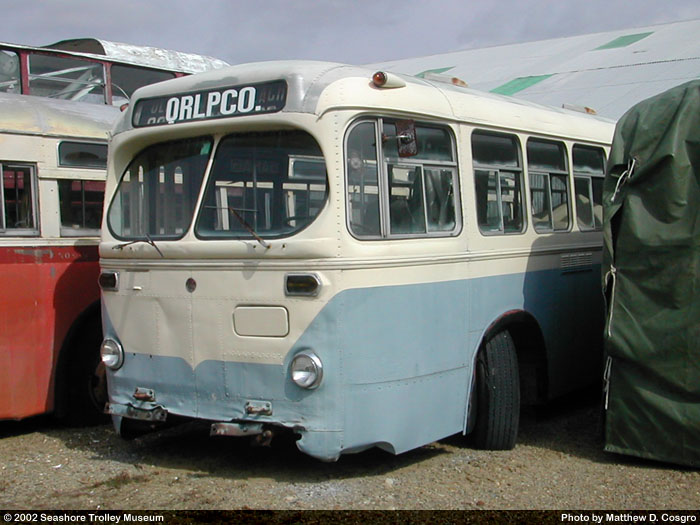
- Builder
- ACF-Brill
- Description
- Model C-36
- Secondary Use
- None
- Type
- Motor Buses
- Year
- 1947
- Retired from Service
- 1977
- Acquired by the Museum
- 1977
- Note
- No. 31 is currently not in operating condition.
- Fund
- 536
Biddeford & Saco Bus Lines 31
From Biddeford, Maine
History
The Biddeford & Saco Railroad provided streetcar service in Biddeford, Saco and Old Orchard, ME. In 1939, the B&S replaced streetcars with a fleet of five ACF buses. This fleet was inadequate and was expanded during after World War II.
ACF-Brill had been formed in a 1944 merger. American Car and Foundry was the country’s largest manufacturer of railroad cars and also made streetcars and interurbans. J.G. Brill had been the largest producer of streetcars and had also produced trolley buses and motor buses. In 1922, ACF ventured into the rubber tired arena with the purchase of Carter Carburetor Corporation. ACF targeted the growing motor coach market and began working with J. G. Brill on acquiring control of Hall-Scott Motor Company, maker of gasoline engines and Fageol Motors, a manufacturer of coach bodies. American Car & Foundry Motors was incorporated in 1925 and controlled Hall-Scott and Fageol Motors. In 1926, the holding company, Brill Corporation, was created to acquire the stock of ACF Motors and J. G. Brill. American Car and Foundry owned 65% of Brill Corporation’s stock. Although controlled by Brill Corporation, ACF Motors and J.G. Brill were not merged together until 1944 to form the ACF-Brill Motors Company. ACF-Brill produced trolley buses and motor buses. The motor buses used Hall-Scott gasoline engines. ACF-Brill became only the fifth largest bus producer. The C-36 bus was one of ACF-Brill’s primary models. ACF-Brill sold 1,546 C-36 buses. In the 1950s, General Motors diesel engine buses took over most of the bus market, and ACF-Brill closed in 1954. Under an agreement with ACF-Brill, Canadian Car & Foundry also built almost 1,000 Model C-36 buses for operators in Canada, ending production in 1955.
ACF-Brill built this Model C-36 bus in 1947 for Lynnfield Community Bus Lines in Lynnfield, MA as their No. 32. Lynnfield Community operated a route between Wakefield and Lynnfield, MA that had previously been operated by Boston & Maine Transportation. The Boston Elevated Railway and several other suburban Boston operators also purchased fleets of A.C.F.-Brill Model C-36 buses, making this a common vehicle in the Boston area after World War II.
In 1949, as part of its effort to expand capacity, Biddeford & Saco Railroad acquired Lynnfield No. 32 where it became B&S No. 25. In 1955, the company changed its name to Biddeford and Saco Bus Lines. The B&S was the last transit company in the U.S. with a 5 cent basic fare until the B&S raised its fare to 10 cents in 1956. In later years, the B&S used No. 31 in school bus service, painted yellow. It also provided shuttle service for an Association of Railway Museums conference at Seashore. In 1972, the B&S renumbered No. 25 to No. 31, taking the spot of two, previously retired Nos. 31.
In 1977, the B&S donated No. 31 to Seashore where it joined the museum’s first vehicle, Biddeford & Saco Railroad streetcar No. 31. The B&S had used Maine commercial bus license plates Nos. 1 -8. B&S President Richard Stride agreed to give Seashore bus license plate 1. Mike Lennon and others went to the B&S to get the plates. The museum registered the plates with Maine motor vehicle and used them on bus No. 31. The most recently registered plates are for the year 2014. In the more recent years, VIP Bus has registered Maine bus license plate 1.
In 1978, a movie company used No. 31 in The Brinks Job, about the 1950 Brinks robbery in Boston. To prepare for the movie, Seashore member Mike Lennon drove No. 31 to the Manchester (NH) Transit Authority’s garage for repainting. Lennon grit blasted the yellow paint from the bus, and No. 31 was repainted in Boston’s Metropolitan Transit Authority colors. For the movie, No. 31 appeared as No. 2502. Afterwards, No. 31 was repainted back into the earlier B&S blue and cream colors. (The blue is 1946 Oldsmobile blue.) While in Manchester, No. 31 appeared in the local Thanksgiving parade down Elm Street with Lennon at the wheel. No. 31 also ran on a Boston Street Railway Association fan trip which ended when the engine overheated.
In 1980-81, Seashore did restoration work on No. 31. In 1989, No. 31 went to Quebec for a provincial exposition. For this, it was lettered “Quebec Railway Light & Power.”
Technical Information
- Seats: 39
- Engine: Hall-Scott 135
- Tires: 10.00 x 20
Weight and Dimensions
- Length: 30’ 9.00"
- Width: 95.00"
- Height: 9’ 6.00"
© 1998 - 2026 New England Electric Railway Historical Society. All Rights Reserved.